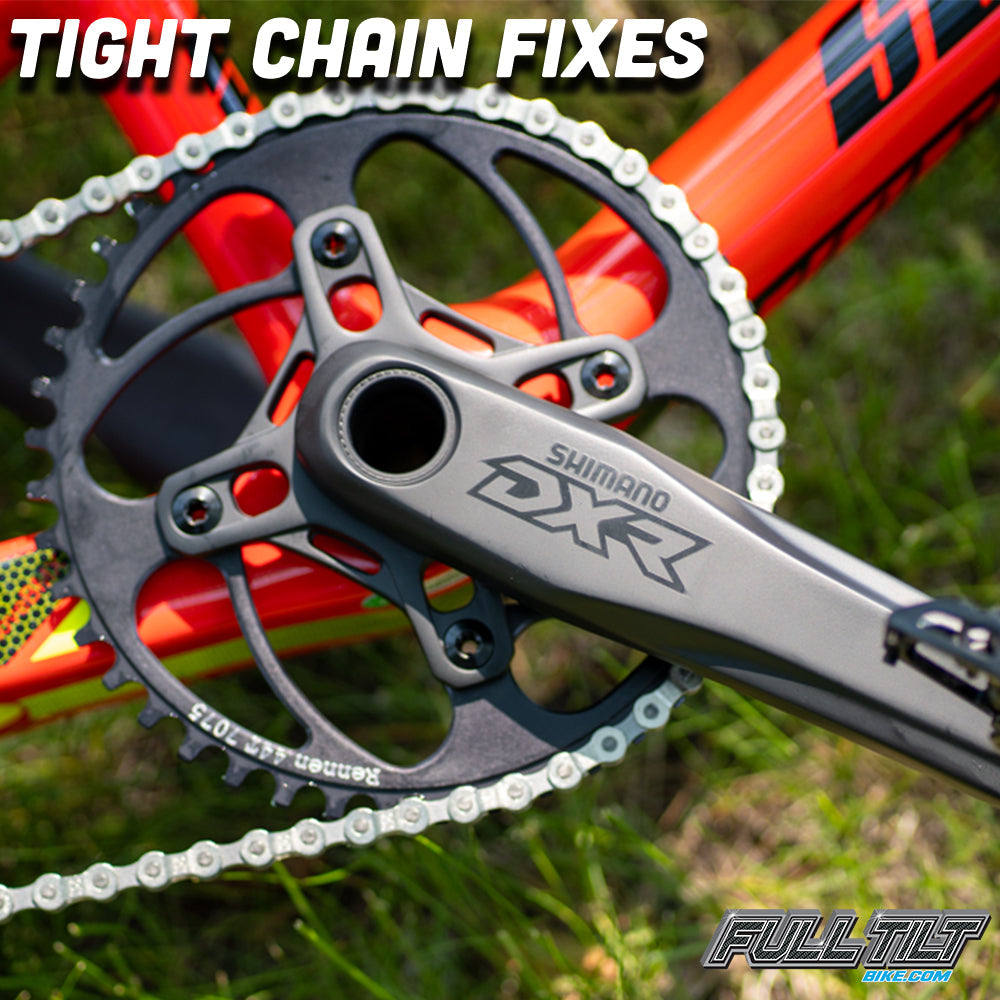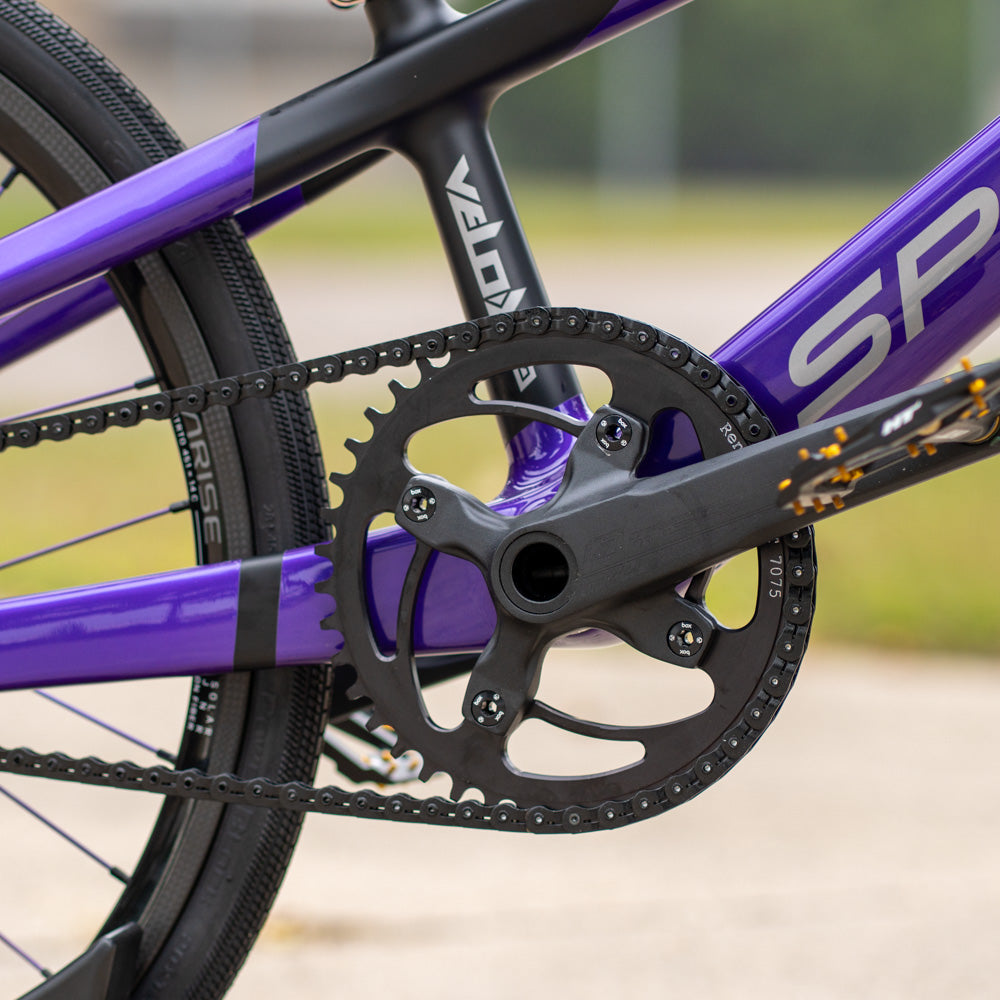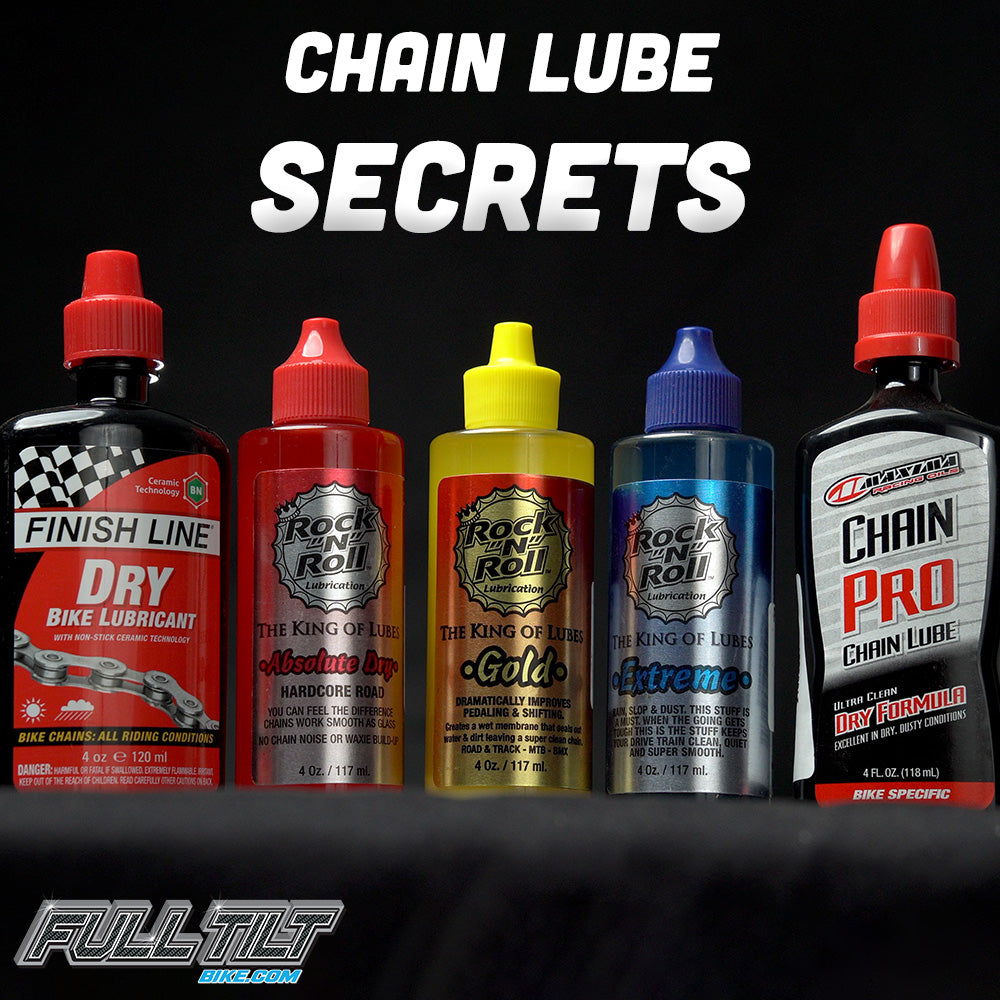Common Culprits and Solutions
Tight spots in a chain are a common issue racers run into. Especially those who are frequently swapping between different gear combos. It often feels like a hiccup in your pedal stroke. While it might sound like a minor annoyance, a tight chain spot can bleed speed and acceleration potential, wear out expensive race parts, or even snap your chain. All things you clearly want to avoid.
So what can be done?
Let's break down the most common causes, layout methods for identifying the problem, and go over various solutions so you can have a smoother, faster, safer drivetrain.
Common Causes of Tight Spots in Bike Chains
Bent Chainring
The chainring is the big toothed disc at the front of the drivetrain. It mounts directly to your crank's spider. If it's not perfectly round, there will be a “high” and “low” point as the chain works through its full rotation. When the chainring is slightly bent or not perfectly round, the chain will be pulled tighter at the "high" point and looser at the "low" point. This is what creates the tight spot that repeats every pedal stroke. Even a small bend can throw everything off.
Bent or Damaged Crank Arm Spider
The crank spider is the piece which the chainring is mounted to. If the spider is even slightly twisted or bent, it doesn’t hold the chainring in a perfect plane. As the crank spins, the misaligned spider pulls the chainring in and out, creating a tight and loose section. You might even see the chain bobbing up and down if you look closely. A bent spider or crank set will never hold the chainring straight creating a tight spot no matter what gear you put on.
Misaligned Chain Line

Your bike chain should run straight from front to back, meeting the chainring and rear cog in a tidy line. If these are not lined up, the chain gets pulled sideways as it cycles around. This sideways force grabs the chain tighter in some spots, especially when you’re using gears that force the chain at an angle. The misalignment also speeds up wear on your chain and cogs, leading to more frequent replacements.
Improper Chain Installation or Joining
When joining a chain—whether with a master link, connecting pin, or another method—each link must pivot freely. If you install a link with too much force or don’t seat it properly, it will feel stiff or “frozen,” refusing to flex around the gears and pulleys. This “stiff link” becomes a tight spot that can click, snap, or even skip under load.

Other Contributing Factors and Diagnosis
Worn Chainring or Cassette Teeth
Shark-toothed or unevenly worn teeth on your chainrings or cassette cogs may grab the chain unevenly. As the worn area cycles around, the chain tightens up where the teeth are damaged. This effect grows worse if the teeth wear unevenly—a common result of riding with a stretched-out chain for too long. Eventually, the chain may ride up instead of seating properly. It's essentially the same result as the chain snapping, the drivetrain fails and you (the rider) go flying into the dirt. Not an ideal situation to find yourself in.

Dry or Dirty Drivetrain Components
A grimy, dry, or rusty chain drags and sticks as it snakes through the gear's teeth. Dirt, dried-up lube, or rust can lock up links, making them more prone to binding or sticking, especially when the chain meets the tightest spots in your drivetrain. You might notice creaks, squeaks, or rattles, along with the tight spot. Routine cleanings or a few dabs of chain lube can quickly solve this issue. Although any signs of chain rust can't really be fixed and should be replaced with a new chain immediately.
How to Diagnose a Tight Spot
Finding a tight spot is straightforward, but takes a careful eye:
- Rotate the pedals backwards by hand with the bike in a stand or flipped upside down.
- Watch the chain tension as it rolls over the chainring and rear cog.
- Look for one section that gets much tighter or seems to jump compared to the rest of the chain.
- If you suspect a stiff link, flex the chain sideways by hand. A stiff link will refuse to bend easily.
- For bent parts or misalignment, remove the chain and spin the crank watching for wobbling in the chainring or spider. To check the spider, remove the chainring and conduct the same test.
- Check the chainring and cog teeth for signs of uneven wear, like sharp points, missing chunks, or raised up edges.
- Inspect the chain, make sure there isn't excessive dirt between the links and that each of the links pivot with relative ease.
Prevention and Solutions for Tight Spots
Routine Chain Maintenance
Routine care can prevent most tight spot issues. Keep these tips handy:
- Clean your chain regularly with a dedicated cleaner or degreaser.
- Lubricate with chain lube every few rides or after washing your bike.
- Wipe off extra lube to avoid attracting grime.
- Visually inspect the chain for kinks, rust, stiff links, or other defects.
- Replace the chain before it’s severely stretched.
Have questions about which chain lube to use? You can learn more about the various chain lube formulas and when to use which right here.
Repair or Replacement Options
If you find a tight spot:
- For a stiff link, manually flex the link side to side or use a chain tool to gently reset the pin.
- Replace bent or damaged chainrings, spiders, or cogs. These cannot be safely straightened.
- If your chain has several stiff links or significant rust, replace it. Chains are cheap; injuries are not.
- For severe alignment problems, adjust the position of bottom brackets, cogs, or spacers as needed.
Professional Help and Best Practices
Some tight spots require a bike shop’s help, especially when you’re not sure what's bent or out of line. Signs you should call a pro:
- You see a wobble in your chainring or crank arm spider.
- You’ve replaced parts but the tight spot persists.
- You’re not confident using a chain tool or adjusting alignment.
If you're looking for some professional help/guidance give us a call. We specialize in bmx race bikes and deal with issues like this one every day.
Best practices for drivetrain health:
- Always use the correct chain for your bike (90% of bmx gears are 3/32 size).
-
Buy CNC machined chainrings which have tighter tolerances and better QC
- Check alignment and tension after every major repair or crash.
- Store your bike indoors if possible to prevent rust.
Best Drivetrain Set Up For Racing:
- CNC machined in the US for tighter tolerances
- Available in decimal teeth allowing for more customizable gearing
- Made in square taper, 5 bolt, & 4 bolt models to match any set up
Rennen chainrings are easily the most popular offering in today's market. The CNC machining allows for tighter tolerances getting each chainring to be as close to perfectly true as possible. It's rare to find an out-of-spec Rennen chainring which is why they're a more premium offering. They're also available in threaded models meaning you no longer need the annoying threaded chainring backer bolts. This feature allows for easy installation and less parts you have a chance of losing.
Another key feature is the decimal sizing Rennen offers. This feature is unique to the brand and allows racers a greater level of customization for gearing rollouts. Most chainrings come in whole tooth increments (44,45,46 teeth etc.) But what if 44t is too small and a 45t is too big? Rennen's decimal gears allow you to choose between a 44.1, 44.2, 44.7, 44.8, and 44.9 meaning you can find the 'sweet spot' for your specific needs or track.
These are also made in all the common drive train set ups, 4 bolt, 5 bolt, and square taper direct mount for the little rippers.
The customization and top-shelf machining is what makes Rennen chainrings a top choice for racers and our personal recommendation for those looking for a silky smooth drivetrain.
- Machined in the US
- Ultra tight tolerances
- Steel and Aluminum versions available
- Durable and built to last
Onyx is best known for their premium race hub offerings but they also produce some high-end drivetrain components as well. The onyx cogs are precision machined in-house at their Minnesota location. Similar to Rennen, the CNC process allows them to produce cogs to produce a higher standard of cogs with control over their own QC.
Onyx cogs bring a certain smoothness to the drivetrain that we find other cogs struggle to match. They're built ultra tough too which is important as cogs don't get swapped out nearly as much as chainrings.
These cogs are made for the Shimano driver (most common driver style) so they mate with nearly all race hubs on the market. Onyx also makes a proprietary cog for their Ultra SS line of hubs which uses a larger driver style. They also come in different materials as well (Steel & Aluminum). The aluminum cogs are offered in various colors and save considerable weight over their steel counterparts. However, these are designed for smaller racers who don't need the crazy durability that steel offers. So if you're over 80-100 lbs, it's best to go with the steel cogs.
Sram PC870 (or other 800 series variants)
- Simplistic yet strong design
- Includes quick detach master link
- Most Affordable option
- Runs smooth on most chainring/cog configurations
It's hard to beat the value Sram chains provide. While it's not the most flashy design, it does it's job well and runs smooth across most chainring/cog combos we see. The sram chain is affordable and very reliable. Just keep an eye on chain wear throughout the season and replace when needed.
There really isn't too much to think about here when it comes to race chains. You just need something strong that runs smooth across the teeth and the Sram does that. This is our baseline recommendation for any drivetrain that comes into the shop.
Now for the younger racer, you might want to check out the hollow pin offering from KMC. The hollow pins save considerable weight over the solid pins of the sram. It's just a lighter design that still runs smooth without adding unnecessary bulk to the system.
There are countless options to consider when it comes to chains, but for the sake of time with this blog we're keeping it simple by giving you two tried and trued solutions that just work. But of course, no drivetrain can function its full capacity without proper lubrication. You can learn more about chain lube specifics here and find the fastest formula for your needs.
Conclusion
A tight spot in your bike chain isn’t just annoying—it’s a sign something is off in your drivetrain. Bent chainrings, misaligned cogs, dirty parts, or bad installations can all cause these issues. Regular cleaning and checks keep your chain rolling smoothly, saving you from breakdowns and costly damage.
Fixing a tight spot doesn’t have to be a headache. Identify the culprit, fix or replace the affected part, and ride happier and safer. Keeping your chain healthy boosts your ride quality, extends the life of expensive components, and keeps you in the race rolling with confidence.
For expert help or questions not answered here, reach out to us and we can assist you with your BMX Racer needs. We're a racer owned company based out of Minnesota equipped with the know-how to get you dialed.






